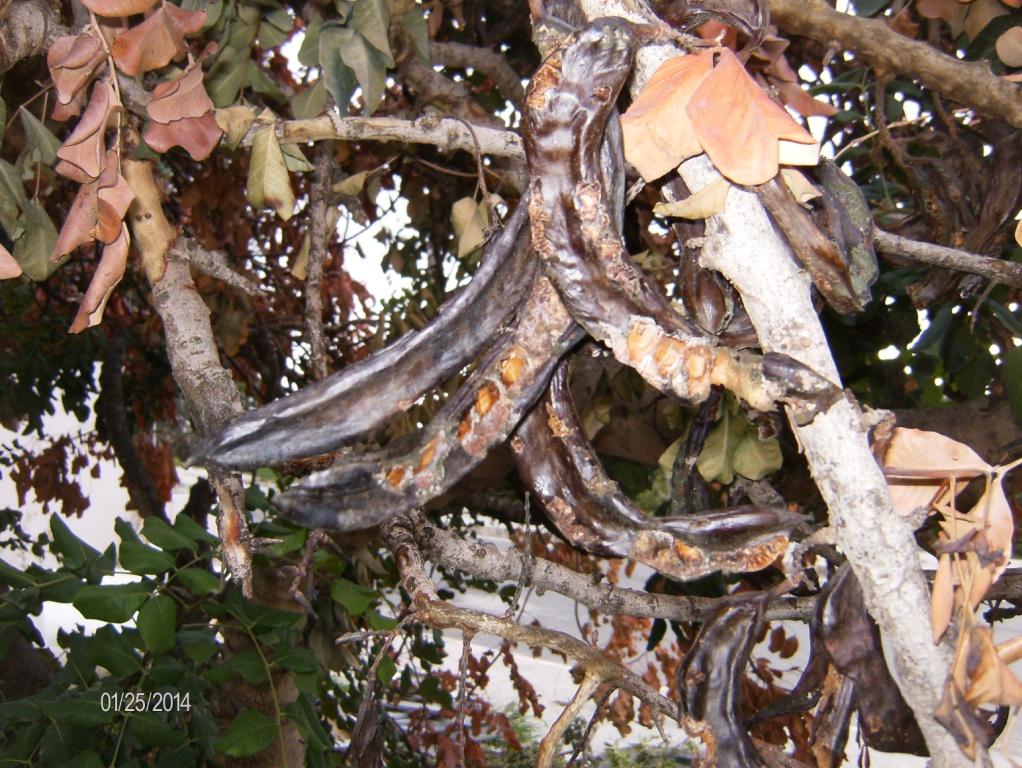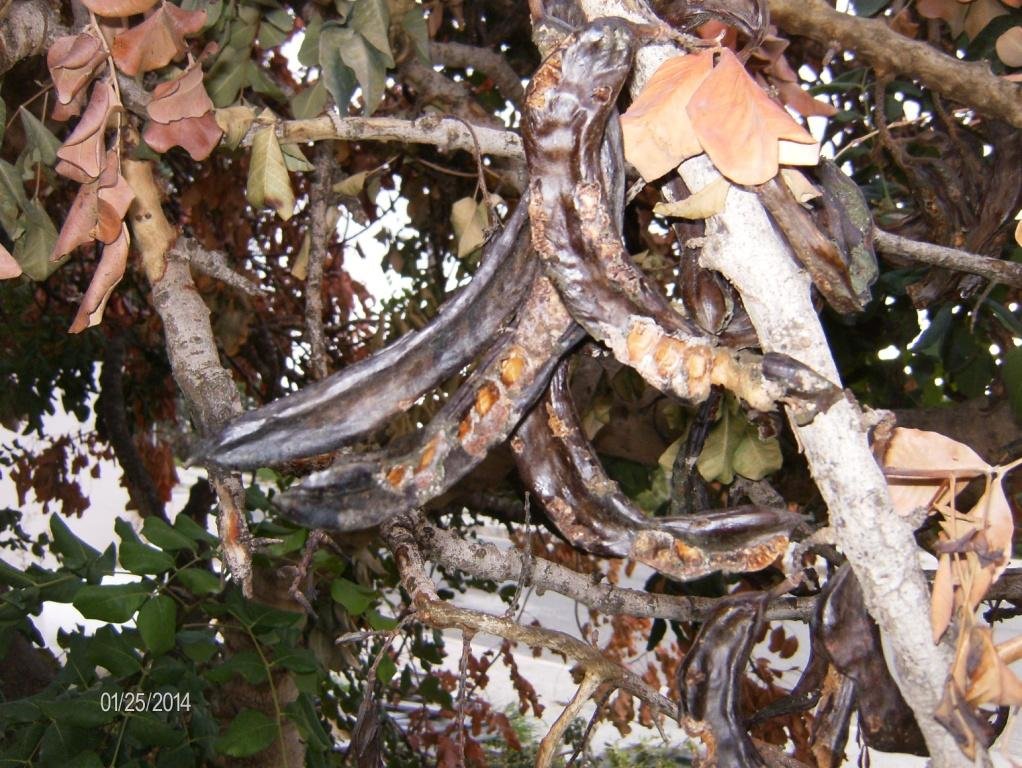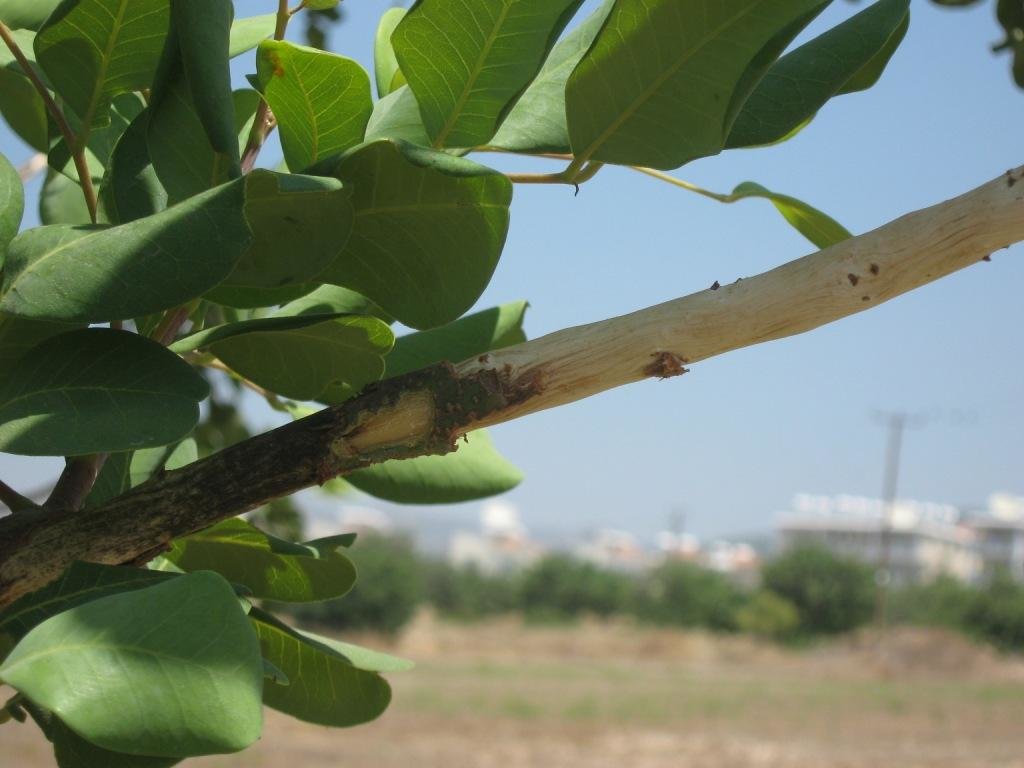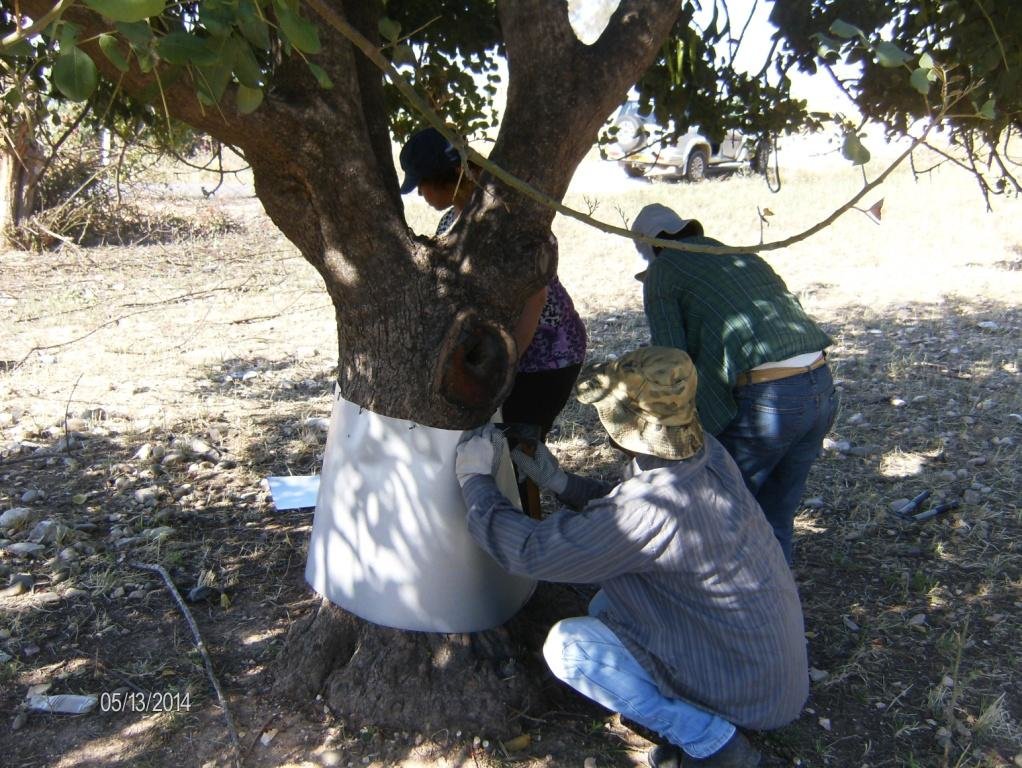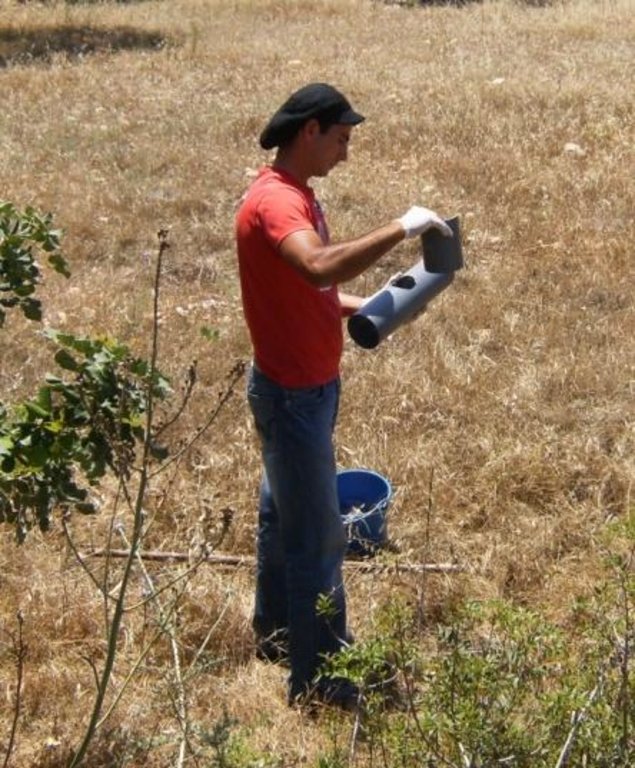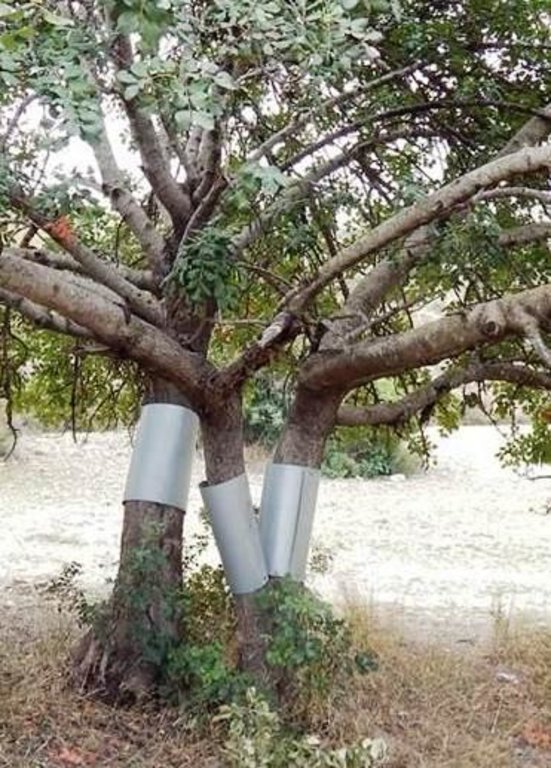Carob tree protection from rats [Кипр]
- Создание:
- Обновить:
- Составитель: Michalakis Christoforou
- Редактор: –
- Рецензент: Fabian Ottiger
Προστασία χαρουπόδενδρων απο προσβολές αρουραίων και ποντικών
technologies_1703 - Кипр
Просмотреть разделы
Развернуть все Свернуть все1. Общая информация
1.2 Контактные данные специалистов и организаций, участвующих в описании и оценке Технологии
Governement official:
Costas Michael
+357-26-804567
costasmichael@ymail.com
Ministry of Agriculture, Rural Development and Environment, Cyprus
B18, Nicosia, Zypern
Кипр
Название проекта, содействовавшего документированию/оценке Технологии (если применимо)
Catastrophic shifts in drylands (EU-CASCADE)Название организации (-ий), содействовавших документированию/оценке Технологии (если применимо)
Cyprus University of Technology (Cyprus University of Technology) - Кипр1.3 Условия, регламентирующие использование данных, собранных ВОКАТ
Когда были собраны данные (на местах)?
01/06/2014
Составитель и ответственный(-ые) специалист(-ы) согласны с условиями, регламентирующими использование собранных ВОКАТ данных:
Да
2. Описание Технологии УЗП
2.1 Краткое описание Технологии
Определение Технологии:
Carrob tree protection from rat attacks include protection of trees directly by using aluminium layers as rings on the neck of the carob trees in order to keep rats away from climbing on the threes and thus causing problens on fruits and new branches. Furthermore, poisonus rat baits are attached on the trees in case the aluminium layers can not be used.
2.2 Подробное описание Технологии
Описание:
Carob trees are attacked every year by rats who nibble the trunk stem of the tree, remove the bark of the trunk and the branches sucking the juice and eat the mature fruits. Rats nibble the bark of the tree in order to reduce their teeth size which tends to enlarge year by year. This results in the death of the tree branch or even of the entire tree. The tree may also show symptoms of hemiplegia. Rats run on the tree through the trunk. Apart from the direct effect of rat attacks on carob trees, rats also cause other problems to humans and animals. Rats are vectors for serious pest and diseases
Purpose of the Technology: The rat population increases rapidly when there is enough food (such as carobs) available, and the population grows even faster in the absence of natural enemies. . Through interrupting the access from the ground to the tree trunk, or by pruning the branches which are connected to the ground, the rats are hindered from climbing the trees. Rats can also be controlled through the use of chemical baits. However, these baits should only be used by experts who know where and how to place them in order to avoid that other animals come in contact with the baits. Natural enemies such as cats, snakes and birds (e.g. Bam owl (Tyto alba)) should be breeded and established on the carob trees, and farmers, hunters and locals should be informed not to kill the natural enemies of rats.
Establishment / maintenance activities and inputs: The carob trees can be protected from rats by covering the tree neck and trunk from the ground up to 1 meter with a hard material such as aluminium with a slippery surface. This way the rats are not able to climb the trees since they will slither on the ring layer.
Natural / human environment: The carob tree protection will increase the production of carobs and therefore the income of the growers. Already established carob trees could provide a good income to growers with low production cost. The population of rats will decrease since the major source of food will not be provided anymore. Educating farmers, hunters and the local population about the benefits of natural enemies will allow that the environment regulates the rat population by itself.
2.3 Фотографии, иллюстрирующие Технологию
2.5 Страна/ регион/ места, где применяется Технология, информация о которых собрана в данной Анкете
Страна:
Кипр
Административная единица (Район/Область):
Limassol
Более точная привязка места:
Pissouri
Map
×2.6 Сколько лет применяется данная Технология
Если год начала применения Технологии достоверно неизвестен, дайте примерную оценку:
- 10-50 лет назад
2.7 Внедрение Технологии
Укажите, как именно Технология УЗП была внедрена:
- как инновация (инициатива) землепользователей
Пояснения (тип проекта и т.д.):
The use of aluminium layer covering the trunk of carob trees was applied in an EU project called Agrolife which started in 2014, http://agrolife.eu/
3. Классификация Технологии УЗП
3.2 Текущий(-ие) тип(-ы) землепользования на территории, где применяется Технология

Пахотные угодья и плантации
- Древесные и кустарниковые культуры
Основные сельскохозяйственные культуры (товарные и продовольственные):
Majors cash crop: Carobs
Пояснения:
Major land use problems (compiler’s opinion): Rat attacks on carob trees cause severe problems for plants health and the fruit quality and production.
Major land use problems (land users’ perception): Carob growers: Rats are attacking the carob trees causing the death of the trees and damage of fruits.
Locals: The rat population increased during the last 30 years especially in areas where carobs are grown.
Agricultural officer: Rat population increased rapidly causing serious problems in carob production due to heavy rainfall in 2012 and to the hunting and killing of the natural enemies such as snakes and birds by the locals and the farmers.
Livestock is grazing on crop residues
3.3 Дополнительная информация о землепользовании
Обеспеченность водой участков, где реализуется Технология :
- сочетание богарных и орошаемых земель
Число урожаев за год:
- 1
Поясните:
Longest growing period in days: 210Longest growing period from month to month: mid October to mid May
3.4 Категория УЗП, к которой относится Технология
- Комплексная борьба с сельскохозяйственными вредителями и болезнями (включая органическое сельское хозяйство)
- Tree protection
3.5 Распределение Технологии по площади
Пояснения:
Total area covered by the SLM Technology is 50 m2.
Carob trees are grown in dry lands such as Pissouri and its sorrounding villages. In Cyprus a total of 4000 hectares with 300'000 carob trees are cultivated. The annual production of carobs is around 9000 to 12000 tons. Carob growers use minimum agricultural practices such as mechanical weed control and pest control (insects and rats)
3.6 Мероприятия УЗП, выполняемые в рамках Технологии

Агрономические мероприятия
- A6: Другие

инженерные мероприятия
- И11: Другие

управленческие мероприятия
- У7: Другие
Пояснения:
Main measures: structural measures
Specification of other structural measures: covering the tree trunk with aluminium layer
3.7 Основные проблемы деградации земель, на решение которых направлена Технология

биологическая деградация
- Бк: сокращение количества биомассы
- Бб: рост числа вредителей/болезней
Пояснения:
Main type of degradation addressed: Bp: increase of pests / diseases, loss of predators
Secondary types of degradation addressed: Bq: quantity / biomass decline
Main causes of degradation: other human induced causes (specify) (Hunting and killing the natural enemies such as snakes and birds)
Secondary causes of degradation: Heavy / extreme rainfall (intensity/amounts) (Rat popuation increases rapidly after rainy year)
3.8 Предотвращение и снижение деградации земель, или восстановление нарушенных земель
Укажите цель Технологии по отношению к деградации земель :
- предотвращение деградации земель
- снижение деградации земель
Пояснения:
Main goals: prevention of land degradation, mitigation / reduction of land degradation
4. Технические характеристики, мероприятия по практической реализации, вложения и стоимость
4.1 Технический рисунок, иллюстрирующий Технологию
4.2 Спецификация / пояснения к техническому рисунку
Aluminium layers are placed aroud the bark of carob trees as a ring. The aluminium is thin and light thus does not affect the growth of the tree. The hight of the aluminium is more than 50cm so that the rats can not climb or jumb on the bark of the tree
Location: Pafos. Pafos
Date: 10/3/2014
Technical knowledge required for field staff / advisors: high (Agricultural advisors will inform the land users about the rat life cycle and their charactiristics in order to understand the use of the technology)
Technical knowledge required for land users: high (land users will implement the technology by installing the zinc or alluminium layers around the tree trunk)
Technical knowledge required for wildlife department: low (will release natural enemies such as the bird Tyto alba)
Main technical functions: reduction of rat population, protection of carob trees and fruits
Structural measure: tree trunck cover with aluminium layer
Height of bunds/banks/others (m): 1
Width of bunds/banks/others (m): 0,1
Length of bunds/banks/others (m): 1
Construction material (other): aluminium layers 1m X 1m X 0,01mm
4.3 Общая информация по необходимым вложениям и стоимости
другая/ национальная валюта (название):
euro
Укажите обменный курс между долларом США и местной валютой (если уместно): 1 доллар США =:
0,91
Укажите среднюю дневную заработную плату наемных работников:
33.00
4.4 Мероприятия, необходимые для начала реализации
| Деятельность | Тип мероприятия | Сроки | |
|---|---|---|---|
| 1. | covering the tree trunk with an aluminium layer | Инженерные | winter, spring |
4.5 Вложения и затраты, необходимые для начала реализации
| Опишите затраты | Единица | Количество | Затраты на единицу | Общая стоимость на единицу | % затрат, оплаченных землепользователями | |
|---|---|---|---|---|---|---|
| Оплата труда | Labour | ha | 1,0 | 265,0 | 265,0 | 100,0 |
| Оборудование | Tools | ha | 1,0 | 1,0 | 1,0 | 100,0 |
| Строительные материалы | Aluminium layer | ha | 1,0 | 1116,0 | 1116,0 | 100,0 |
| Строительные материалы | Iron nails | ha | 1,0 | 11,0 | 11,0 | 100,0 |
| Общая стоимость запуска Технологии | 1393,0 | |||||
Пояснения:
Duration of establishment phase: 3 month(s)
4.6 Поддержание/ текущее обслуживание
| Деятельность | Тип мероприятия | Сроки/ повторяемость проведения | |
|---|---|---|---|
| 1. | Control of aluminium layers | Инженерные | once a year |
4.7 Стоимость поддержания/ текущего обслуживания ( в год)
Пояснения:
Machinery/ tools: hammer, nails
The costs were calculated for 8 persons working 8 hours per day and per ha. The costs were calculated on the 28th of August 2015.
4.8 Наиболее значимые факторы, влияющие на стоимость затрат
Опишите наиболее значимые факторы, влияющие на стоимость затрат:
The costs are affected by the trunk diameter and the plant height
5. Природные и социально-экономические условия
5.1 Климат
Среднегодовое количество осадков
- < 250 мм
- 251-500 мм
- 501-750 мм
- 751-1000 мм
- 1001-1500 мм
- 1501-2000 мм
- 2001-3000 мм
- 3001-4000 мм
- > 4000 мм
Пояснения/ комментарии по осадкам:
Total annual rainfall in 2013=255mm
Total annual rainfall in 2014=363mm, and in 2015=300mm from Jan to May
Агроклиматическая зона
- полузасушливая
Thermal climate class: subtropics. In Jan and Feb the temp can go below 5 C for few hours in one or two days.
5.2 Рельеф
Склоны (преобладающие):
- пологие (0-2%)
- покатые (3-5%)
- покато-крутые (6-10%)
- крутые (11-15%)
- очень крутые (16-30%)
- чрезвычайно крутые (31-60%)
- обрывистые (>60%)
Формы рельефа:
- плато/ равнины
- гребни хребтов/холмов
- склоны гор
- склоны холмов
- подножья
- днища долин
Зона высотной поясности:
- 0-100 м над уровнем моря
- 101-500 м н.у.м.
- 501-1000 м н.у.м.
- 1001-1500 м н.у.м.
- 1501-2000 м н.у.м.
- 2001-2500 м н.у.м.
- 2501-3000 м н.у.м.
- 3001-4000 м н.у.м.
- > 4 тыс. м н.у.м.
Комментарии и дополнительные сведения по условиям рельефа/ топографии :
Altitudinal zone: 0-100 m a.s.l (most of carob trees areas)
Landforms: Plateau/plains (most trees are planted in plateaus. The technology is not affected by landform)
Slopes on average: Flat (most of the plantations), gentle (some fields) and moderate (few plantations, old age carob trees)
5.3 Почвы
Средняя мощность почв:
- поверхностные (0-20 см)
- неглубокие (21-50 см)
- умеренно глубокие (51-80 см)
- глубокие (81-120 см)
- очень глубокие (> 120 см)
Гранулометрический состав (верхнего горизонта):
- средние фракции (суглинистый, супесчаный)
- тонкодисперсный/ тяжёлый (глинистый)
Содержание органического вещества в верхнем горизонте:
- среднее (1-3%)
- низкое (< 1%)
Если возможно, приложите полное описание почв или укажите доступную информацию, например тип почв, рH/ кислотность почв, ёмкость катионного обмена, содержание азота, содержание солей и т.д.
Soil depth on average: Moderately deep (plateaus, flat areas) and shallow (hills with aged carob trees)
Soil texture: mdeium (in plateaus and flat areas) and fine (mostly on the base of the hill)
Soil fertility is medium in plateaus and flat areas and low mostly on the base of the hill
Topsoil organic matter is medium (in plateaus and flat areas) and low (mostly on the base of the hill)
Soil drainage/infiltration is good
Soil water storage capacity is low (due to lack of rainfall, when it rains the water is immediately absorbed by the soil)
5.4 Доступность и качество воды
Уровень грунтовых вод:
5-50 м
Доступность поверхностных вод:
недостаточны/ отсутствуют
Качество воды (без обработки):
исключительно для сельскохозяйственного использования (орошение)
Комментарии и дополнительная информация по качеству и количеству воды:
Ground water table is 5-50m (if a field is near a river) and >50m if a field is far from rivers
Availability of surface water is poor/none (When it rains it does not last long enough in order to cause floods)
Water quality (untreated) is for agriculutral use only ( ground water analysis showed that in some cases the water is contaminated with boron)
5.5 Биоразнообразие
Видовое разнообразие:
- низкое
Комментарии и дополнительная информация по биоразнообразию:
Few species grow within the carob trees and those are mostly weeds. Once a year the growers remove the weeds from the fields. Fauna is also poor and consists of rodents, snakes, few birds and insects
5.6 Характеристика землепользователей, применяющих Технологию
Рыночная ориентация производства:
- смешанное (самообеспечение/ товарное хозяйство
Доходы из других источников:
- > 50% всех доходов
Относительный уровень достатка:
- плохой
- средний
Индивидуальное или коллективное хозяйство:
- частное/ домовладение
Уровень механизации:
- ручной труд
- механизировано/ есть автотранспорт
Пол:
- женщины
- мужчины
Укажите другие важные характеристики землепользователей:
Land users applying the Technology are mainly common / average land users
Difference in the involvement of women and men: Most of the land users are old men and women. Very few young men are involved in the carob tree production.
Population density: 10-50 persons/km2
Annual population growth: negative
20% of the land users are average wealthy and own 50% of the land.
80% of the land users are poor and own 50% of the land.
Off-farm income specification: Since rat attack is the most damaging factor affecting the growth of carob trees and the quality of the product, the land users who apply the technology have more income with unsignificant yield losses caused by other factors.
Level of mechanization is manual labour (pruning, irrigation and harvesting) and mechanised (cultivating, weeds control, pesticide applications)
Market orientation is mixed (farmers either sell their products individually or sell them as a group)
5.7 Средний размер земельных участков, арендуемых или находящихся в собственности землепользователей, применяющих Технологию
- < 0,5 га
- 0,5-1 га
- 1-2 га
- 2-5 га
- 5-15 га
- 15-50 га
- 50-100 га
- 100-500 га
- 500-1000 га
- 1000-10000 га
- > 10000 га
Считается ли это мелким, средним или крупным хозяйством (по местным масштабам)?
- мелкое
Пояснения:
Average area of land owned or leased by land users applying the Technology: < 0.5 ha, 0.5-1 ha, 1-2 ha
5.8 Собственность на землю, права на земле- и водопользование
Землевладелец:
- индивидуальная, не оформленная в собственность
- индивидуальная, оформленная в собственность
Право землепользования:
- индивидуальное
5.9 Доступ к базовым услугам и инфраструктуре
медицинское обслуживание:
- плохой
- средний
- хорошая
образование:
- плохой
- средний
- хорошая
технические консультации:
- плохой
- средний
- хорошая
занятость (вне хозяйства):
- плохой
- средний
- хорошая
рынки:
- плохой
- средний
- хорошая
электроснабжение:
- плохой
- средний
- хорошая
транспорт и дорожная сеть:
- плохой
- средний
- хорошая
водоснабжение и канализация:
- плохой
- средний
- хорошая
финансовые услуги:
- плохой
- средний
- хорошая
6. Воздействия и заключительные положения
6.1 Влияние Технологии УЗП в пределах территории ее применения
Социально-экономическое воздействие
Продуктивность
производство сельскозяйственных культур
Количество до применения УЗП :
35 Kg/tree
Количество после применения УЗП:
45-50Kg/tree
Комментарий/ пояснения:
Trunk and branch protection lead to yield increase
риск потери продуктивности
Комментарий/ пояснения:
Although other factor like fire, frost, pests and diseases can cause production failure, rat attack is considered as the most damageable
Доходы и затраты
сельскохозяйственные издержки
Количество до применения УЗП :
1,5 euro/tree
Количество после применения УЗП:
1 euro/tree
Комментарий/ пояснения:
During pruning, large dead branches should be removed
объем работ
Количество до применения УЗП :
50 trees/day
Количество после применения УЗП:
65 trees/day
Комментарий/ пояснения:
During pruning,
Социальное и культурное воздействие
продовольственная безопасность/ самообеспечение
Комментарий/ пояснения:
Carob fruits are free from infectious diseases transferred by rats
состояние здоровья
Комментарий/ пояснения:
Reduction of rat populations within the production area minimizes the risk of man diseases infection like typhos,
Improved livelihoods and human well-being
Комментарий/ пояснения:
The technology improved both livelihoods and human health. The growers income has increased more than 10-20% due to the reduction of the damage caused by rats every year. The reduction of the number of rats minimized the risk of human pathogens such as typhus which was very common in these areas.
Экологическое воздействие
Биоразнообразие: растительность, животный мир
борьба с вредителями/ болезнями
Комментарий/ пояснения:
Increase of predators in the areas around the carob trees since rats can not climb on carob trees
Климат и снижение риска стихийных бедствий
риск пожаров
Комментарий/ пояснения:
Fields with carob trees being attacked by rats are more sensitive to fires since they are abandoned by their owners
Другие экологические последствия
Control of rat population
Quality of carob trees and fruits
Plant growth
Комментарий/ пояснения:
On small trees the aluminium layer is pressing the trunk in a way the tree can not grow normally. In this case the aluminium layer must be replaced with a layer once every few years
6.2 Влияние Технологии за пределами территории ее применения
ущерб прилегающим полям
Комментарий/ пояснения:
rat population around the SLM technology is decreased therefore the damage caused by rats to the neighbours is also decreased
ущерб объектам инфраструктуры общего/ частного пользования
Комментарий/ пояснения:
Decrease in rat population rear farms also decrease the damage caused on the farm infrastructure (wires, wood, plastic equipment), by rats
6.3 Подверженность и чувствительность Технологии УЗП к постепенным изменениям климата и экстремальным погодным явлениям/ стихийным бедствиям, связанным с изменением климата (в понимании землепользователей)
Постепенное изменение климата
Постепенное изменение климата
| Сезон | Тип изменения климата/ экстремального явления | Насколько успешно Технология справляется с этим? | |
|---|---|---|---|
| среднегодовые температуры | увеличилось | хорошо |
Экстремальные явления, связанные с изменением климата (стихийные бедствия)
Погодные стихийные бедствия
| Насколько успешно Технология справляется с этим? | |
|---|---|
| местные ливневые дожди | хорошо |
| местные ураганы | хорошо |
Стихийные бедствия климатического характера
| Насколько успешно Технология справляется с этим? | |
|---|---|
| засухи | хорошо |
Гидрологические стихийные бедствия
| Насколько успешно Технология справляется с этим? | |
|---|---|
| регулярные наводнения (выход рек из берегов) | хорошо |
Другие воздействия, связанные с изменением климата
Другие воздействия, связанные с изменением климата
| Насколько успешно Технология справляется с этим? | |
|---|---|
| сокращение вегетационного периода | хорошо |
Пояснения:
The use of aluminium layers covering the trunk of carob trees is not affected by the climatic conditions. Climatic conditions such as heavy rain could affect the use of plastic tubes which include poisonous bait or the direct poisonous cubes placed on the tree branches.
6.4 Анализ эффективности затрат
Насколько получаемый результат сопоставим с первоначальными вложениями (с точки зрения землепользователей)?
Эффективность затрат в краткосрочной перспективе:
слабо позитивное
Эффективность затрат в долгосрочной перспективе:
очень позитивное
Насколько получаемый результат сопоставим с текущими расходами по поддержанию технологии (с точки зрения землепользователей)?
Эффективность затрат в краткосрочной перспективе:
очень позитивное
Эффективность затрат в долгосрочной перспективе:
позитивное
Пояснения:
Due to the damage caused on the carob trees by rats already, the trees will need some time (2-3 years) to create new branches able to produce fruits. Furthermore no new damages occur on trees.
During the first 3-5 years the aluminium layer can remain on the trees. After this period the aluminium should be replaced with a larger one due to the enlargement of the tree trunk.
6.5 Внедрение Технологии
Если возможно, дайте количественную характеристику (число домохозяйств и/или площадь применения):
10
Среди применяющих Технологию землепользователей, какова доля лиц, применяющих её по собственной инициативе, т.е. без какого-либо материального стимулирования со стороны?
- 90-100%
Пояснения:
100% of land user families have adopted the Technology without any external material support
10 land user families have adopted the Technology without any external material support
Comments on spontaneous adoption: Due to the lack of effective and cheap ways for controlling rat attack on carob trees the land users are adopting the technology, and so far they get positive results.
There is a little trend towards spontaneous adoption of the Technology
Comments on adoption trend: Few other land user are interested in adopting the technology. Many other land users are not adopting the technology because they inherited the land and they are not actually working on the land in order to make profit.
6.7 Сильные стороны/ преимущества/ возможности Технологии
| Сильные стороны/ преимущества/ возможности по мнению землепользователей |
|---|
| easy to install |
| the technology can be used over a long time |
| Сильные стороны/ преимущества/ возможности по мнению составителя или других ключевых специалистов |
|---|
|
the technology can be used over a long time How can they be sustained / enhanced? use of non-oxidizing material |
|
the aluminium layer can be bent easily How can they be sustained / enhanced? both vertical edges should be hold each other by the use of a spur |
| low cost |
| easy installation |
6.8 Слабые стороны/ недостатки/ риски Технологии и пути их преодоления
| Слабые стороны/ недостатки/ риски по мнению землепользователей | Возможные пути их преодоления/снижения? |
|---|---|
| the aluminium layer can be a target for thieves who steal metal |
| Слабые стороны/ недостатки/ риски по мнению составителя или ответственных специалистов | Возможные пути их преодоления/снижения? |
|---|---|
| the aluminium layer should be replaced in time because the trees are growing in size | install larger aluminium layers and lold it with spring |
| The aluminium (metal) can overheat during summer time | Spray the layer with white paint |
Ссылки и модули
Развернуть все Свернуть всеСсылки
Нет ссылок
Модули
Нет модулей


